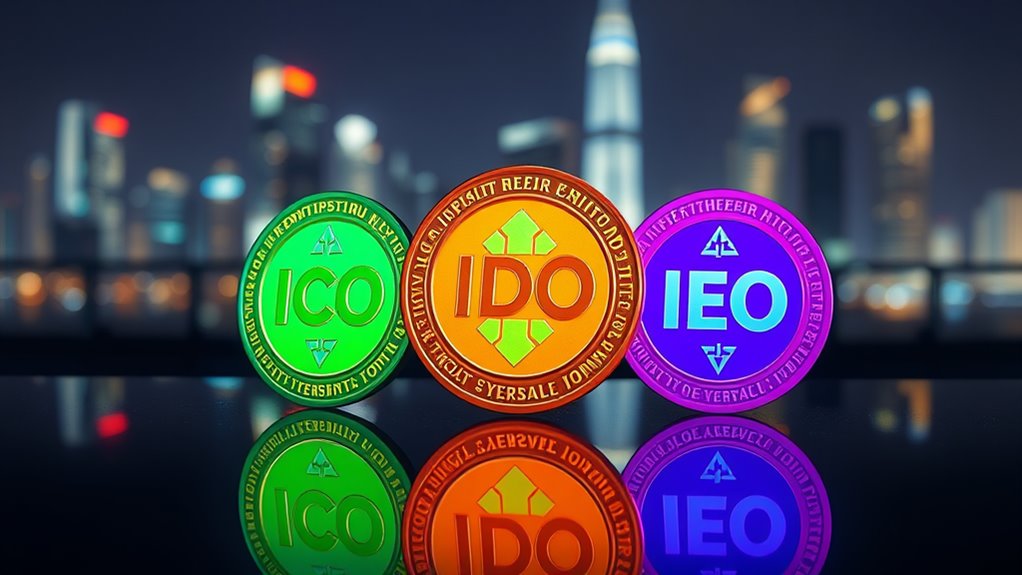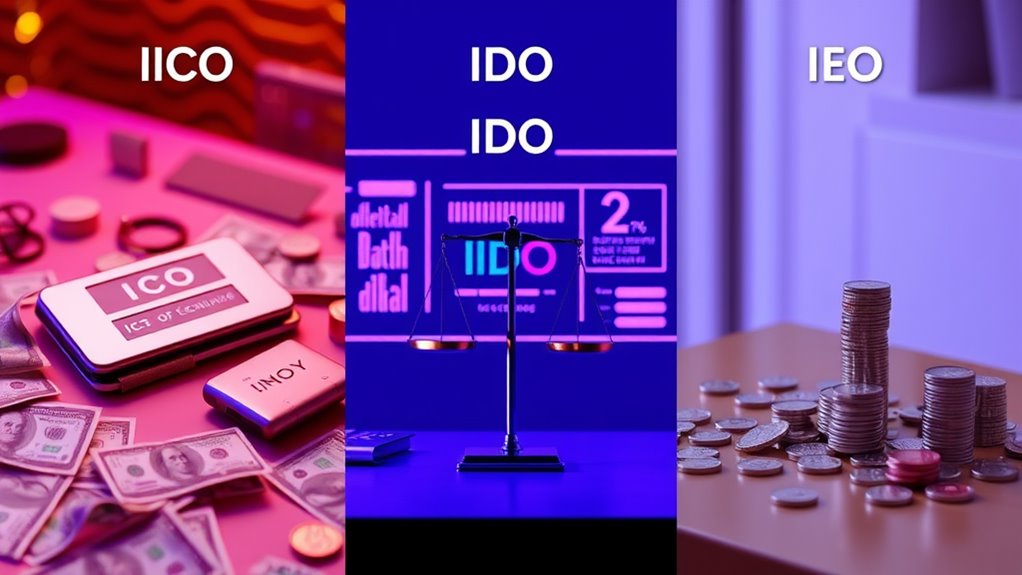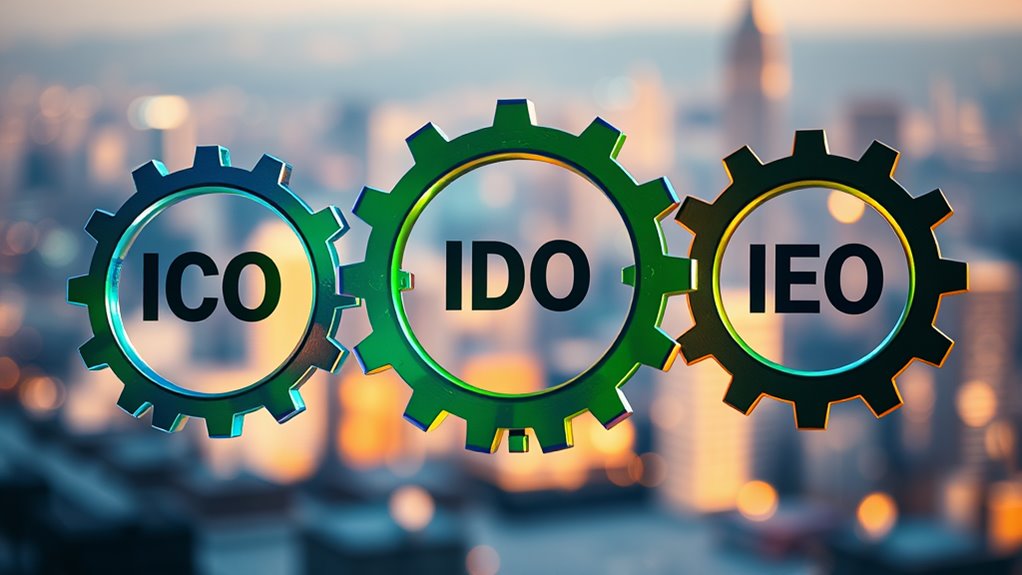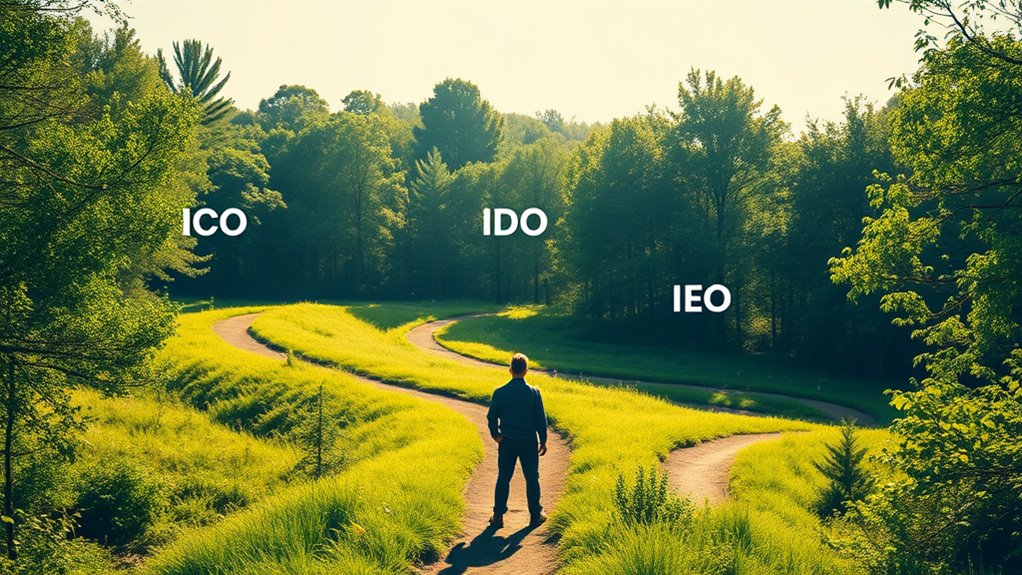
Difference Between ICO, IDO, and IEO: What Are They?
ICOs, or Initial Coin Offerings, allow projects to raise funds directly through their websites, issuing tokens in exchange for established cryptocurrencies. IEOs, or Initial Exchange Offerings, take place on centralized exchanges, which provide regulatory support and security. IDOs, or Initial DEX Offerings, happen on decentralized exchanges, promoting accessibility and immediate trading of tokens. Each method has distinct structures, compliance requirements, and accessibility, influencing investor participation and fundraising dynamics. Exploring these differences can clarify their unique roles in crypto finance.
Key Takeaways
- ICOs (Initial Coin Offerings) are conducted on project websites, allowing direct control but often lack regulatory oversight, increasing fraud risks.
- IEOs (Initial Exchange Offerings) occur on centralized exchanges, offering enhanced security and compliance due to exchange vetting processes, but incur higher costs.
- IDOs (Initial DEX Offerings) take place on decentralized exchanges, promoting accessibility and immediate token trading, though they can face smart contract vulnerabilities.
- Liquidity is generally higher for IEOs due to immediate exchange listings, while ICOs may experience delayed trading opportunities.
- Costs for ICOs are typically lower initially, while IEOs face significant listing fees, and IDOs reduce reliance on intermediaries to lower long-term expenses.
Understanding ICOs: Initial Coin Offerings Explained

Initial Coin Offerings, commonly referred to as ICOs, represent a modern fundraising mechanism used by cryptocurrency projects to generate capital.
Through ICOs, companies issue tokens to participants in exchange for established cryptocurrencies like Bitcoin or Ether. This method allows projects to raise funds directly, bypassing traditional financial intermediaries and minimizing bureaucracy.
However, ICOs often operate in unregulated environments, which exposes investors to significant risks, including fraud. Successful examples, such as Ethereum’s 2014 ICO, have raised substantial amounts, yet many ICOs fail to meet their funding goals or collapse shortly after.
The process involves distributing tokens, setting funding goals, and creating detailed whitepapers to outline project objectives, making ICOs a unique alternative to traditional funding methods. The potential for high returns in successful ICOs emphasizes the need for thorough research and caution when investing.
Exploring IEOs: The Role of Initial Exchange Offerings

Initial Exchange Offerings (IEOs) serve as a secure fundraising method for cryptocurrency projects by utilizing the oversight of centralized exchanges.
These exchanges not only guarantee compliance with regulations but also provide immediate liquidity for investors once the tokens are sold.
Participation in IEOs generally requires users to be registered on the exchange, which enhances security and fosters trust among potential investors. Furthermore, IEOs allow projects to leverage the exchange’s credibility to attract a larger audience and ensure a smoother investment process.
IEO Security Benefits
IEOs are managed by cryptocurrency exchanges, which oversee the token sale process and handle smart contracts, along with Know Your Customer (KYC) and Anti-Money Laundering (AML) checks.
This exchange involvement reduces the risk of fraudulent projects, as exchanges conduct thorough due diligence to vet projects before allowing them to launch an IEO.
Additionally, the reputation of established exchanges fosters trust among investors and enhances the protection of funds through advanced security protocols.
Consequently, IEOs present a more secure and reliable fundraising option in the evolving cryptocurrency landscape. Moreover, their integration of automated KYC processes helps ensure compliance with regulatory standards, further safeguarding investors and projects alike.
Participation Requirements
Participation in Initial Exchange Offerings (IEOs) involves several essential requirements that potential investors must meet to engage in the fundraising process. Investors are required to create an account on the exchange hosting the IEO and complete Know Your Customer (KYC) and Anti-Money Laundering (AML) verifications. Additionally, funding their exchange accounts with supported cryptocurrencies is necessary. Some exchanges may prioritize participation for institutional investors or those holding the exchange’s token, while geographic restrictions may limit participation based on the exchange’s operational areas. Furthermore, IEOs typically offer immediate liquidity for the tokens sold, which can be an attractive feature for investors.
| Requirement | Description | Notes |
|---|---|---|
| Account Creation | Create an account on the hosting exchange | Crucial for participation |
| KYC/AML Compliance | Complete necessary verifications | Required to guarantee regulatory compliance |
| Funding Requirements | Fund account with supported cryptocurrencies | Necessary for token purchase |
| Eligibility Criteria | Priority may be given to certain investor types | Depends on the exchange |
| Geographic Restrictions | Limited to countries where the exchange operates | Varies by exchange |
Market Liquidity Advantages
Market liquidity plays a significant role in the success of fundraising efforts through Initial Exchange Offerings (IEOs).
IEOs provide high liquidity because tokens are listed immediately on exchanges after the fundraising period. This immediate availability is a key advantage over Initial Coin Offerings (ICOs), where tokens often face longer listing times, leading to delayed liquidity.
In contrast, Initial DEX Offerings (IDOs) also guarantee rapid liquidity through decentralized exchanges using automated market makers (AMMs). Additionally, Initial Liquidity Offerings (ILOs) can provide instant liquidity, making them appealing for investors. As the landscape evolves, deeper integration with DeFi is expected to further enhance liquidity options for both IEOs and IDOs.
Delving Into IDOS: Initial DEX Offerings Uncovered

Initial DEX Offerings (IDOs) present various advantages, such as immediate liquidity and lower costs for both projects and investors.
However, they also carry risks, including potential scams and regulatory uncertainties, which necessitate careful research and planning.
Understanding these benefits and challenges is essential for participants looking to engage in this increasingly popular fundraising method. Additionally, participants should familiarize themselves with the project’s tokenomics to make informed decisions during the IDO process.
Benefits of IDOs
As decentralized finance continues to evolve, Initial DEX Offerings (IDOs) have emerged as a compelling fundraising method for cryptocurrency projects.
One significant benefit of IDOs is immediate liquidity, as tokens become tradable on decentralized exchanges (DEXs) right after the sale. This instant access enhances market participation.
Additionally, IDOs promote decentralization and accessibility, minimizing the role of intermediaries and allowing global participation. They also incur lower costs due to reduced administrative burdens.
The use of smart contracts enhances security and transparency, ensuring fair token distribution and reducing fraud risks.
In addition, IDOs foster community engagement, which is vital for sustainable project growth, making them an attractive option for both developers and investors in the cryptocurrency space. Furthermore, IDOs implement anti-whale mechanisms to ensure a fair distribution of tokens among participants.
Risks and Challenges
While IDOs present innovative fundraising opportunities, they are not without significant risks and challenges that potential investors and project developers must navigate.
Price volatility can lead to substantial financial losses, while smart contract vulnerabilities may expose funds to security threats. The lack of regulation increases the likelihood of scams and fraudulent projects participating in these offerings.
Additionally, decentralized exchanges (DEXs) often face scalability issues, limiting the funds that can be raised. The technical complexity of DEXs can deter inexperienced users, and token lock-up periods may affect liquidity.
Moreover, the legal status of IDOs remains uncertain, complicating compliance and investor protection. Regulatory uncertainty is a crucial factor that can further complicate the landscape for IDOs. Overall, understanding these risks is essential for informed participation in IDOs.
Key Differences in Platforms: Where Fundraising Occurs

Fundraising in the cryptocurrency space occurs through various platforms, each with distinct characteristics that influence how projects raise capital.
Initial Coin Offerings (ICOs) typically occur on a project’s website or specific launchpads, providing full control to the project team. In contrast, Initial Exchange Offerings (IEOs) take place on centralized exchanges like Binance, benefiting from their user bases and regulatory oversight.
Initial DEX Offerings (IDOs) are conducted on decentralized exchanges, allowing global access but requiring some technical knowledge for participation. While ICOs and IEOs are more centralized, IDOs emphasize decentralization.
Additionally, IEOs offer immediate liquidity through exchange listings, whereas IDOs provide rapid trading opportunities on decentralized platforms, highlighting the diverse environments in which fundraising can occur. It’s essential for investors to remain vigilant against scams, especially in decentralized fundraising models like IDOs.
Security and Regulatory Compliance: Assessing Risks

The various fundraising methods in the cryptocurrency sector come with distinct security and regulatory compliance risks that potential investors and project teams must consider.
ICOs often lack centralized oversight, increasing susceptibility to fraud and scams, while also facing challenges related to regulatory compliance across multiple jurisdictions.
In contrast, IEOs benefit from exchange support, which enhances compliance but incurs higher costs and exposes projects to exchange vulnerabilities.
IDOs, operating on decentralized exchanges, risk smart contract flaws and pricing volatility due to their lack of central control.
Each method presents unique regulatory challenges, with ICOs frequently in a legal gray area, while IEOs enforce stricter compliance measures, underscoring the need for thorough risk assessments before participation. Additionally, prospective investors should be aware of the potential threats associated with ICOs, which include fraudulent schemes like ponzi schemes and exit scams.
Liquidity and Market Listing: How Tokens Trade

Understanding how tokens trade is essential for investors maneuvering through the cryptocurrency market, as liquidity and market listing play crucial roles in determining a token’s performance.
Initial Coin Offerings (ICOs) often experience low liquidity since tokens may not be listed on exchanges immediately after the sale, resulting in delayed trading opportunities. In contrast, Initial Exchange Offerings (IEOs) enjoy higher liquidity due to immediate listings on centralized exchanges, benefiting from their established user bases.
Meanwhile, Initial DEX Offerings (IDOs) facilitate trading on decentralized exchanges, allowing for quicker market access. The choice of fundraising method greatly influences how quickly and effectively tokens can be traded, impacting investor confidence and the overall market dynamics surrounding each token.
Investor Participation and Accessibility: Who Can Join?

When exploring the landscape of cryptocurrency fundraising, it is essential to take into account who has the opportunity to participate in different types of offerings.
Initial Coin Offerings (ICOs) are accessible to anyone with an internet connection and compatible cryptocurrencies, although some jurisdictions impose restrictions.
In contrast, Initial Exchange Offerings (IEOs) require participants to have accounts on centralized exchanges, often with Know Your Customer (KYC) requirements for added security.
Initial DEX Offerings (IDOs) operate on decentralized platforms, allowing anyone with a digital wallet to join, regardless of location.
However, IDOs may necessitate prior registration to manage demand.
Each method presents varying levels of accessibility, security, and participation conditions, influencing investor choices in the cryptocurrency market.
Costs and Fees: Comparing Fundraising Expenses

In the domain of cryptocurrency fundraising, the costs associated with ICOs, IEOs, and IDOs vary considerably.
ICOs typically have lower initial costs due to the absence of listing fees, while IEOs incur higher expenses from listing fees and commissions.
Conversely, IDOs reduce reliance on intermediaries, often leading to lower long-term expenses, despite costs related to smart contract management.
ICO and IEO Costs
The costs associated with Initial Coin Offerings (ICOs) and Initial Exchange Offerings (IEOs) can vary considerably, impacting the financial strategies of projects seeking to raise funds.
ICOs often face significant regulatory costs, marketing expenses, and the need for thorough whitepaper development. Additionally, setting up smart contracts and conducting security audits further increase their expenses.
In contrast, IEOs incur listing fees to exchanges, percentage-based fees from raised funds, and compliance costs for Know Your Customer (KYC) and Anti-Money Laundering (AML) requirements.
While ICOs allow direct engagement with investors, IEOs rely on exchanges for credibility, which may lead to higher indirect costs.
Ultimately, each fundraising model presents distinct financial implications that projects must carefully consider.
IDO Expense Advantages
IDO fundraising models present several expense advantages that differentiate them from ICOs and IEOs. Primarily, IDOs operate on decentralized exchanges, which means lower or even nonexistent listing fees. This decentralization allows projects to engage directly with their communities, minimizing reliance on intermediaries. However, some technical expertise is required for setup and management.
| Cost Component | Estimated Cost Range |
|---|---|
| Core Features | $5,000 – $15,000 |
| UI/UX Design | $4,000 – $10,000 |
| Smart Contract Development | $10,000 – $30,000 |
| Blockchain Integration | $5,000 – $15,000 |
| Testing and Security Audits | $5,000 – $40,000 |
These factors contribute to a more efficient fundraising approach, enhancing market participation with immediate token trading.
Future Prospects: The Evolving Landscape of Fundraising

How will the future of crypto fundraising develop in an ever-changing market? The landscape is poised for transformation as several factors come into play.
- Market Dynamics: New fundraising models will emerge, addressing past challenges.
- Regulatory Clarity: Clear regulations will help stabilize the market, fostering investor confidence.
- Technological Advancements: Enhanced security and accessibility will encourage broader adoption of fundraising methods.
- Investment Trends: A shift towards stablecoins and DeFi projects indicates a preference for more stable financial instruments.
These elements combined indicate an evolving environment where innovation in blockchain technology opens new avenues for fundraising.
Innovation in blockchain technology is paving the way for new and diverse fundraising opportunities in an evolving market.
This makes it essential for participants to stay informed and adaptable in this dynamic sector.
Investment Caution: Navigating Risks in Crypto Fundraising

Steering through the risks associated with crypto fundraising requires careful consideration, as various factors can considerably impact the success of investment efforts. Investors must be aware of the regulatory environment, security risks, and market volatility. Conducting due diligence is essential, as thorough research on a project’s leaders and technology can protect investments. The table below highlights key risks and strategies for mitigation.
| Risk | Mitigation Strategy |
|---|---|
| Lack of Regulation | Understand legal compliance |
| Market Volatility | Diversify investment portfolio |
| Security Risks | Implement robust security measures |
| Financial Loss Potential | Stay informed on market trends |
Frequently Asked Questions
How Do I Choose the Right Fundraising Model for My Project?
To choose the right fundraising model, one must consider project control, regulatory compliance, target audience, risk tolerance, and liquidity needs, ensuring alignment with project goals and investor expectations for a successful fundraising strategy.
What Are the Tax Implications of Participating in ICOS, IDOS, or IEOS?
The tax implications of participating in ICOs, IDOs, or IEOs include income recognition for issuers, capital gains tax for investors, and varying regulations based on jurisdiction, necessitating diligent record keeping for compliance.
Can I Invest in ICOS, IDOS, or IEOS Anonymously?
Statistics show that approximately 80% of ICOs require minimal personal information. While ICOs and IDOs often allow anonymous participation, IEOs typically necessitate more personal data due to regulatory compliance, limiting anonymity for investors.
What Happens if a Project Fails After Raising Funds?
When a project fails after raising funds, investors often face total loss without recourse. This failure can damage trust, harm reputations, and impact future fundraising efforts within the broader cryptocurrency ecosystem.
How Can I Verify the Legitimacy of a Fundraising Project?
To verify a fundraising project’s legitimacy, one should assess transparency through documentation, check regulatory compliance, evaluate the backing of reputable entities, review community feedback, and consider auditing processes to enhance confidence in the investment.
Conclusion
In conclusion, ICOs, IEOs, and IDOs represent distinct fundraising methods in the cryptocurrency world, each with unique characteristics and implications for investors. As of 2021, it was reported that over $13 billion was raised through ICOs alone, highlighting the significant interest in these funding avenues. Understanding the differences among these options is essential for potential investors. By considering factors such as security, accessibility, and costs, individuals can make more informed decisions in this evolving financial landscape.












